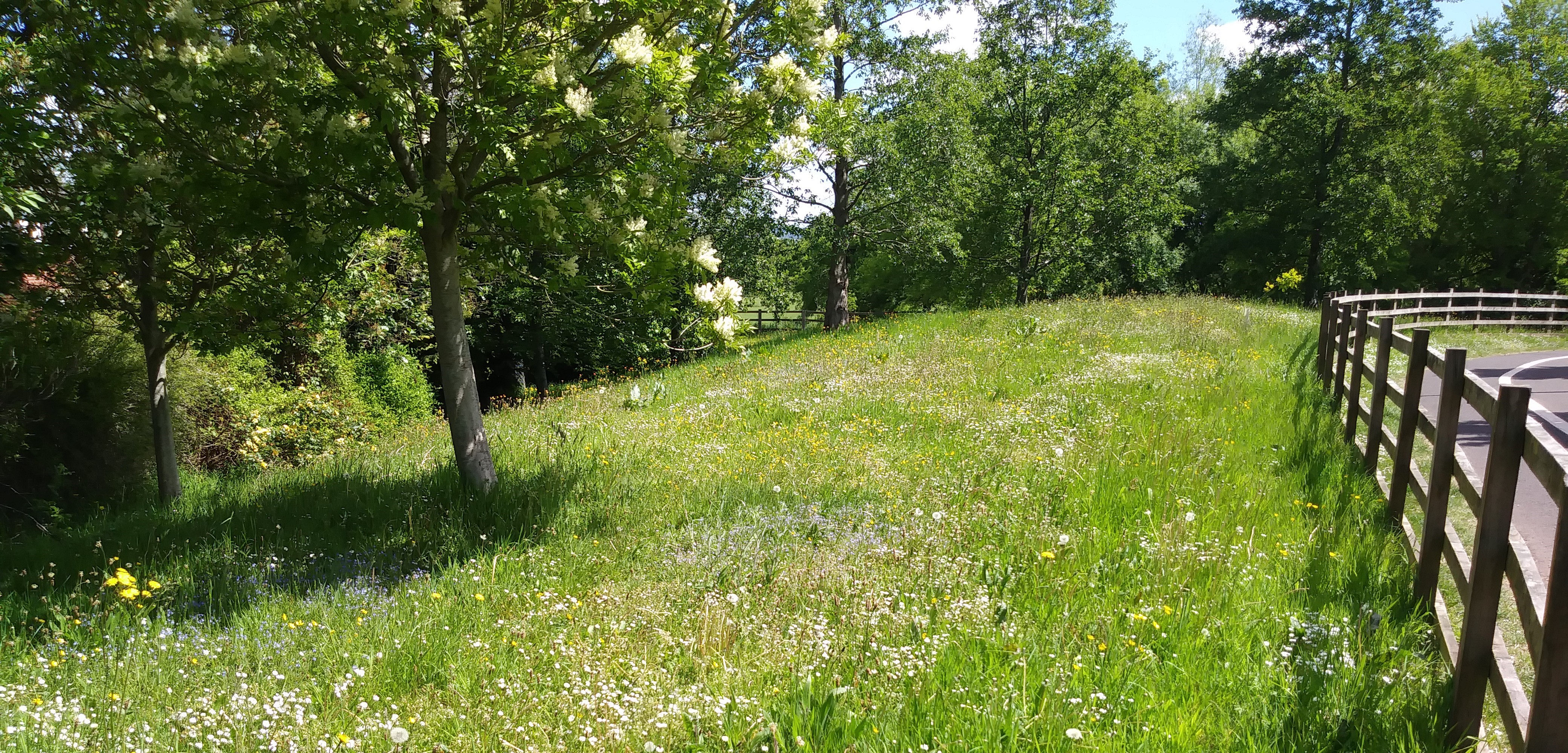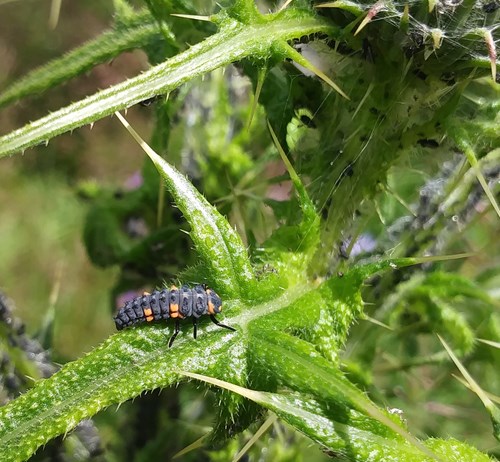Boosting Nature in Green Spaces

an area beautifully managed for biodiversity
Mid Devon District Council manages a wide range of Open Spaces across the district that includes formal parks, playing fields, play areas, general open spaces, cemeteries and closed churchyards.
Where possible, we are in the process of improving the variety of habitats within in these areas to benefit biodiversity and environmental sustainability.
Why is this important?
Mid Devon’s beautiful rural landscape can make it easy to forget that Nature is collapsing at an alarming rate.
Globally, monitored population sizes of mammals, fish, birds, reptiles and amphibians have declined, on average, by 69% between 1970 and 2018, according to World Wildlife Fund’s (WWF) 2022 Global Living Planet Index.
Similar trends have been observed locally; in our region, populations of once common birds such as swifts and cuckoos have plummeted in the past 25 years alone.
A range of interacting factors are behind the decline in biodiversity and wildlife. These include changes in land use and land management, the use of pesticides and other pollutants, the modification of our waterways, the presence of invasive non-native species, and climate change. This matters to all of us because of the vital role that wildlife and nature play in supporting our wellbeing, society and economy.
Aims
- To provide attractive, accessible and well-maintained parks and recreational spaces
- To protect and enhance biodiversity within those areas
Strategies
- Reduce the frequency of grass cutting to the minimum level that still allows reasonable recreational use of open spaces. Since 2017 the frequency of grass cutting on the majority of open spaces has been reduced by 40%. In addition to the benefits of longer grass there is an associated reduction in the machinery and fuel that is used with a corresponding reduction in carbon that is produced.
- Where possible, suitable sites have been removed from routine grass cutting and these are maintained on a Conservation Regime. On these areas grass cutting only takes place once or twice a year.
- Some sites receive minimal intervention and are left as natural areas to benefit flora and fauna.
- Where it is safe to do so we will leave standing dead wood to be used by invertebrates.
- Mid Devon no longer plants annual bedding plants and has moved towards the use of herbaceous or woody species that are attractive to pollinator insects. There are a small number of floral bedding displays in some of the major towns that are provided by the local Town Councils.
- Plant more trees and hedges.
- Use native tree species wherever possible sourcing plants of UK provenance.
- Establish Community Orchards.
- Work with local groups and members of the public on tree planting and other conservation projects.
- Green material produced from tree and shrub pruning is chipped and re-used as mulch wherever possible.
- Mid Devon does not use any peat based products.
List of sites maintained on a Conservation Area regime
- Old Park, Tiverton – large sloping area of land, footway/rides mown through
- Community Orchard, Tiverton – footways mown through for access
- Tiverton Cemetery – large areas of grass left; mowing will recommence when plots required for burials
- Crediton Cemetery – as above, plus species-rich Devon bank on northwest boundary
- Cullompton Community Association Field, Cullompton – linear area along riverside footpath
- Linear Park/Millennium Way Open Space, Cullompton – species rich banks along footpath and embankment behind play area
- Beacon Park, Crediton – area of open space left to encourage wildflowers
- Paradise riverside area, Tiverton
- Culmstock Closed Churchyard – now managed for conservation purposes in partnership with the Church. As an experiment for the first time in 2023, sheep were used to graze one section
- Hemyock Closed Churchyard – managed for conservation by the Church
- South View Road, Willand – large grass area adjacent to road managed to benefit native flora
- All areas that have been planted with whips (small young trees) over the last two winters (see sites below)
Minimal - Intervention Areas
- Railway Walk, Tiverton – both sections
- Large area of wooded slope below Palmerston Park, Tiverton
- Queen Elizabeth Drive, Crediton
- Disused Railway Line at Culmstock
Pollinator and Wildflower Areas
- Newcombes Meadow, Crediton – circular wild flower area created, former bedding areas and rose beds replanted with perennial pollen-rich plants, these areas are maintained by Sustainable Crediton
- St Lawrence Green, Crediton – similar to above and planted and maintained by Community Group
- Crediton Cemetery – area at entrance previously formal bedding replaced with wildflower mix
- People’s Park, Tiverton – pollinator bed created at entrance to park
- Vale Vets and MacDonald’s roundabouts, Tiverton – sown with wildflower mix

Areas of Tree Planting
Tiverton
- Starkey Close
- Graters Copse
- Old Park
- Oak Close
Crediton
- Beacon Park
- Greenway
- Lords Meadow
- Barnfield
Cullompton
- Crowbridge Park
- Crossparks
Community Orchards
Tiverton
- Oak Close
- Mountbatten Way
Newton St Cyres
- Orchard Close Community Orchard – Newton St Cyres
A Statement on Herbicide and Pesticide Use
In common with many other Local Authorities, Mid Devon has greatly reduced the use of herbicides to the very minimum and teams are using cultural and manual methods instead.
Herbicides are only used to control weeds where other methods of control are ineffective or prohibitively expensive. An example is the stem injection to control Japanese Knotweed, the use of Eco plugs to prevent regrowth from tree stumps or weed control on sports turf.
We do not treat shrub and rose beds with any residual or contact herbicides to control weed growth, instead these areas are mulched using a sustainable material produced during winter pruning operations.
The Council no longer routinely sprays hard surfaces such as car parks or pavements to control weeds and only treats existing weed growth, if required, to prevent structural damage or to assist in flood prevention.
Mid Devon does not use pesticides to control any pest, disease or fungus on amenity turf or plants.
Where areas of moss on footways represent a slip hazard the areas are now treated with mechanical brushes and not sprayed.
MDDC will consider any viable alternative methods of weed control, such as, hot foam application, thermal lances or weed brushes, as the technology develops.
What you can do
If you have a garden, or patch of land, you can help tackle the biodiversity crisis - here are a few suggestions:
- Introduce water - a pond, or even a small dish of water will bring in wildlife
- Create an area, no matter how small, to be left for nature
- Mow grass areas less frequently and take part in Plantlife’s ‘No Mow May’ campaign
- Create habitat piles by leaving piles of cut branches and grass that make great homes for grass snakes and hedgehogs
- Cut hedges and shrubs every 3 – 5 years on rotation to ensure food and nesting sites for wildlife
- Choose plants that provide pollen or nectar for as long a season as possible
- Provide food and water for birds all year round
Other Sources of Information
Buglife Advice Sheet Managing-Parks-and-Green-Spaces-for-Pollinators-08.pdf (buglife.org.uk)
Plantlife www.plantlife.org.uk
Royal Horticultural Society RHS Plants for Pollinators - Garden plants